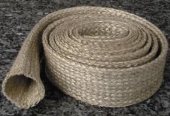Up to 5" diameter -
http://www.vermiculitecoated.com/high-temperature-heat-resistant-thermal-insulation-sleeve-tape-rope-fabric-firesleeve.html
1500°F / 815°C: Braided Vermiculite Coated Fiberglass Sleeve: Premium
Grade. Very High Temperature & Heat Resistant
FlameShield™ braided fiberglass sleeve with
specialty coating of Vermiculite.
Available in thin wall (1/16 in. / 1.6mm.) and
thick wall (1/8 in. / 3.18mm.).
1500°F / 815°C continuous exposure with
excursion to 2000°F / 1093°C.
1500°F / 815°C continuous rating, high insulation value & excellent personnel protection
The Vermiculite coating adds abrasion resistance and higher temperature capabilities which makes this sleeve a good
insulator for hose, cable and copper or aluminum tubing.






